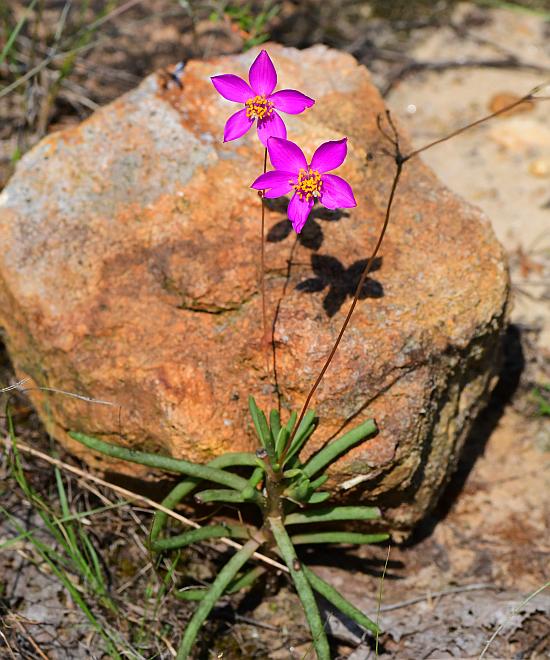Phemeranthus calycinus (Engelm.) Kiger
Fame Flower

Native
CC = 8
CW = 5
MOC = 48
© SRTurner
Phemeranthus calycinus (Engelm.) KigerFame Flower | |
 |
Native CC = 8 CW = 5 MOC = 48 |
© SRTurner |
|
Family - Portulacaceae Habit - Perennial forb. Rootstocks unbranched or more commonly with few to several branches, each developing a stem. Stems - Ascending to erect, short, to 7 cm, sometimes apparently absent, occasionally sprawling, succulent-thickened, glabrous.
Leaves - Alternate, crowded along stems, sometimes appearing as a basal rosette or nearly so, sessile. Leaf blades 1.5-7.0 cm long, more or less tubular and relatively strongly succulent, linear, truncate and often slightly expanded at the base, angled or tapered to a sharply pointed tip, glabrous, sometimes appearing slightly glaucous. Stipules absent.
Inflorescences - Long-stalked, open panicles, the stalk 5-25 cm long, occasionally 1-or few-branched toward the stalk base, the branch(es) producing a second inflorescence. Flowers short-to long-stalked, occasionally appearing sessile, hypogynous, occasionally some functionally cleistogamous flowers present. Inflorescence divisions subtended by pairs of tiny scarious bracts to 1 mm long. Pedicels 5-6 mm long, glabrous, expanded beneath calyx.
Flowers - Sepals 4-6 mm long, shed as the flower opens. Petals 5, 10-16 mm long, 5-9 mm wide, bright reddish pink to reddish purple, shed quickly after the flower opens. Stamens 25-45, the anthers yellow to orangish yellow. Filaments pinkish, glabrous, 7 mm long. Ovary superior, green, glabrous, ovoid, the style fused nearly to the tip, the stigma appearing solitary, irregularly capitate, 3-lobed.
Fruits - Ovoid capsules 6-8 mm long. Seeds numerous, 0.8-1.2 mm long, the surface smooth, shiny, black. Flowering - May - October. Habitat - Glades and ledges and tops of bluffs, usually on acidic substrates but occasionally on calcareous substrates. Origin - Native to the U.S. Lookalikes - P. parviflorus. Other info. - This small but striking species is restricted to specialized habitats and is not often observed, although it occurs throughout the southern half of Missouri. Its main range comprises areas of Missouri and a few states to our west. Both flowers and leaves are highly distinctive. The leaves are tubular and succulent, and the flower color is one of the most vivid and saturated to be found anywhere. The plant favors level areas and does not take well on slopes. It often grows in rocky glade areas that seemingly have no soil. A similar species, P. parviflorus, has much smaller flowers (5-7 mm) with fewer stamens (4-8). This latter species is less common in Missouri. Photographs taken at Lichen Glade, MO., 6-7-03, and at Dave Rock Conservation Area, MO., 6-16-05 (DETenaglia); also at Hughes Mountain Natural Area, Washington County, MO, 5-14-2012, Buford Mountain Conservation Area, Iron County, MO, 5-15-2017, and Don Robinson State Park, Jefferson County, MO, 9-10-2021 (SRTurner). |